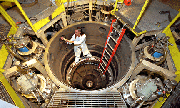|
Sandia National Laboratories Beam Weapons Research |
||
| Sandia National Laboratories
is operated by Lockheed Martin Corp. for the U.S. Department of Energy.
1991: DESERT STORM: According to Defense News, April 13 - 19, 1992, the US deployed an electromagnetic pulse weapon (EMP) in Desert Storm, designed to mimic the flash of electricity from a nuclear bomb. The Sandia National Laboratory had built a 23,000 square meter laboratory on the Kirkland Air Force Base, 1989, to house the Hermes II electron beam generator capable of producing 20 Trillion Watt pulses lasting 20 billionths to 25 billionths of a second. This X-ray simulator is called a Particle Beam Fusion Accelerator. A stream of electrons hitting a metal plate can produce a pulsed X-ray or gamma ray. Hermes II had produced electron beams since 1974. These devices were apparently tested during the Gulf War, although detailed information on them is sparse... NOTE: Sandia's main site in Albuquerque, New Mexico, established 50 years ago under Truman, administration, shortly after Roswell. |
||
|
SANDIA NATIONAL LABORATORIES/NEW MEXICO
Date Established: 1945.
Primary - National security programs in defense, energy,
and environment with primary emphasis on nuclear weapons research, development,
and stockpile stewardship.
SNL/NM has 546 major buildings, totaling 4.6 million gross square feet. Operations are conducted in six locations, called Technical Areas l, ll, lll, lV, and V, the Manzano storage area, and the Coyote Test Field. Technical Area I (TA-I) contains the site's administrative, site support, technical support, component development, research, energy programs, microelectronics, defense programs, and exploratory systems. Technical Area II (TA-II) was established for casting and assembling chemical high- explosive main charges for nuclear weapons and is now in the process of being cleaned up. Technical Area III (TA-III) is used for testing and simulation of a variety of natural and induced environments for nuclear weapons and other non-weapons programs and includes two rocket-sled tracks, two centrifuges, and a radiant heat facility. Technical Area IV (TA-IV) is a remote research location for pulsed power sources. These include x-ray, gamma-ray, particle beam fusion, and accelerators, all of which are used to simulate nuclear weapon effects and to conduct research on inertial- confinement fusion and weapon physics. Technical Area V (TA-V) is the remote research area where experimental and engineering nuclear reactors, hot cells, and gamma irradiation facilities are located. The Manzano storage area contains structures authorized to store nuclear material and waste. The classified nuclear and radioactive materials (fissile and non- fissile) are stored on a long-term basis. The Coyote Test Field contains testing operations that require large land areas and unusual terrain, separated by large buffer zones. Facilities include explosively driven shock tubes, aerial cable sites for high-speed ground target impact tests, a test site where large quantities of cased conventional explosives can be detonated, numerous small explosive sites, igloos for storing explosives, and a laser strain seismometer. Some of these facilities are seldom used. SOURCE: http://www.globalsecurity.org/wmd/facility/sandia_nm.htm
|
||
Pulsed Power Facilities: Saturn
Accelerator

The Saturn accelerator is a modular, high-power, variable-spectrum,
x-ray simulation source. Saturn can be operated with two different bremsstrahlung
diodes or any one of several plasma radiation sources. The diodes and sources
provide x-ray radiation environments with enhanced simulation fidelity
based on fast rise time, short pulse duration, and tailored spectral content.
Saturn is used to simulate the radiation effects of nuclear countermeasures
on electronic and material components, as a pulsed-power and radiation
source, and as a diagnostic test bed. - SOURCE
Building 981, Saturn Accelerator This particle beam fusion accelerator facility provides threat-level x-ray effects testing and experiments on complex electronic systems, such as reentry body arming, fuzing, and firing assemblies, with high spectral and temporal fidelity. Saturn also provides high temperature, large volume hohlraums and other cold x-ray environments for weapon physics experiments supporting the stockpile stewardship program. - SOURCE |
||
| Pulsed Power Accelerator:
Achieves Record-Breaking X-ray Outputs
ALBUQUERQUE, N.M. -- A pulsed power accelerator at Sandia National Laboratories has in recent weeks quadrupled its output and demonstrated its ability to pump out 85 terawatts of power -- more than 50 times the output of the U.S. utility grid -- causing scientists to revise their estimates of the power levels that can ultimately be achieved. Such power levels are important in ensuring the safety of the nation’s nuclear weapon stockpile. Data generated inside Saturn and other Sandia accelerators are used to test three-dimensional computer codes that simulate what happens inside a nuclear weapon when it detonates. Simulations such as this are increasingly important as the United States seeks a worldwide ban on nuclear testing. The record-breaking outputs were achieved after Sandia researchers tinkered with target arrays that produce the magnetic implosions. Though predicted analytically, the high output levels were only recently achieved experimentally. The breakthrough has "altered the mindset we’ve been operating with" about Saturn's capabilities, says Don Cook, Director of Sandia's Pulsed Power Sciences Center. "Controlling the symmetry of the implosion was the key." In simplest terms, a pulsed power accelerator such as Saturn uses a series of capacitors, or electrical dams, to build and store electrical charges over a period of time, then simultaneously discharge them in fractions of a second. As the electrical floodgates open, the resulting electrical pulse drives very high currents through a target area. Collectively these currents -- something like a tight bundle of lightning bolts -- generate a magnetic field that "squeezes" objects in the target area. In recent Saturn experiments, circular arrays of fine tungsten wires placed in the target area are ionized into a hot plasma and their masses driven toward their axis in billionths of a second by the compressive force of the electromagnetic field. This magnetic implosion in turn causes the split-second release of hundreds of thousands of joules of X-ray energy. The faster and more symmetrically the masses are squeezed together, the more X-ray power is generated in the implosion. SOURCE: http://www.sandia.gov/media/saturn.htm A brief history of Saturn Today's Saturn accelerator was originally commissioned in 1980 as Particle Beam Fusion Accelerator I (PBFA I). When PBFA II was commissioned in 1986, PBFA I was reconfigured as a high-energy X-ray source. PBFA I was recommissioned as Saturn in 1987 and has been used as a laboratory X-ray source since. Currently the Labs operates four major pulsed power accelerators: PBFA II, Saturn, Hermes, and SABRE (for Sandia Accelerator and Beam Research Experiment). Sandia is a multiprogram Department of Energy laboratory, operated by a subsidiary of Lockheed Martin Corp. With facilities in Albuquerque, N.M., and Livermore, Calif., Sandia has major R&D responsibilities in national defense, energy, environmental technologies, and economic competitiveness. |
||
Pulsed Power Facilities: Z Accelerator
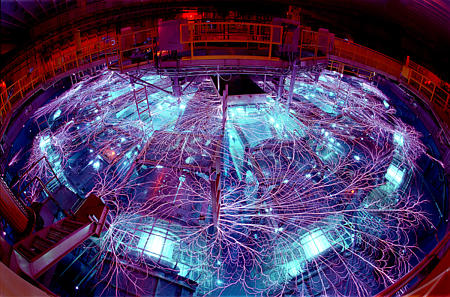
"Arcs and Sparks" Zmachine firing. Time-exposure photograph of electrical flashover arcs produced over the surface of the water in the accelerator tank as a byproduct of Z operation. These flashovers are much like strokes of lightning (click on image for full size) Z is the world's most efficient (15%) and powerful laboratory x-ray source, producing x-ray powers in excess of 200 trillion watts. When the five-year project to refurbish Z is completed in 2007, x-ray energies of nearly three million joules and x-ray powers exceeding 300 trillion watts should be possible. Another dramatic climb toward fusion conditions for Sandia Z accelerator Huge pulsed power machine enters fusion arena Z produces fusion neutrons, Sandia scientists confirm |
||
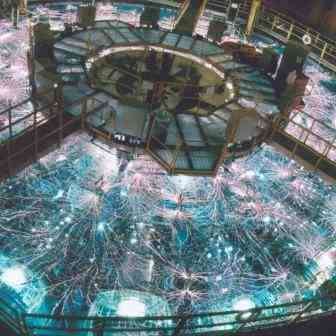
The x-ray sources on Z can produce plasmas similar to that in the very outermost layers of a star. The Z Accelerator - An Intense X-Ray Source Building 983, Particle Beam Fusion Accelerator II (PBFA II) This building is used as laboratory space to generate intense ion beams in support of the inertial confinement fusion program. It has produced a lithium ion beam with 10 million volts of kinetic energy and has focused this beam to a world's record intensity of 1.5 trillion watts per square centimeter, resulting in a specific power deposition of 1500 trillion watts per gram. - SOURCE Another dramatic climb toward
fusion conditions for Sandia Z accelerator
Z produces fusion neutrons, Sandia
scientists confirm
Sandia’s Z machine exceeds two
billion degrees Kelvin
Ice created in nanoseconds by
Sandia’s Z machine
|
||
Pulsed Power Facilities: Z-Beamlet
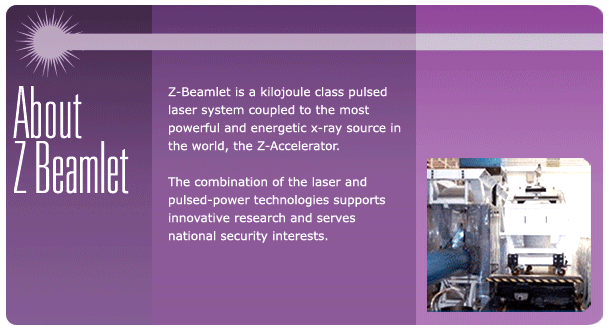
Z-Backlighter Laser The Z-Backlighter Laser (ZBL) is the third largest pulsed laser in the world. It provides x-ray images of imploding capsules and wire-array dynamics on Z experiments. - SOURCE |
||
| PULSED POWER FACILITIES:
HERMES III ACCELERATOR 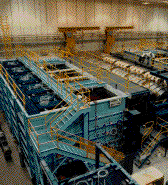
The High-Energy Radiation Megavolt Electron Source
(HERMES) III accelerator is the world's most powerful gamma simulator,
producing 13 TW of power in a 19-MeV, 700-kA, 28-ns electron beam. HERMES
uses technology developed by Pulse Sciences, Inc. and Sandia National Laboratories
in the joint Defense Special Weapons Agency/Department of Energy Linear
Induction Accelerator program, and can provide eight shots per day, four
days per week. HERMES III has both indoor and outdoor test cells, and is
used primarily for simulating the effects of prompt radiation from a nuclear
burst on electronics and complete military systems. The accelerator is
housed in Sandia's Simulation Technology Laboratory. - SOURCE
|
||
| Pulsed Power Facilities: RHEPP
I
Sandia's Repetitive High-Energy Pulsed Power (RHEPP) I facility is an operational testbed for the development of IBEST technology. This 1 MV, 25 kA, 60 ns pulse-width ion accelerator has operated at an output beam power of 90 kW. - SOURCE |
||
| PULSED POWER FACILITIES: RITS
Accelerator
The Radiographic Integrated Test Stand (RITS) accelerator was built as a test bed for research and development of pulsed power drivers and radiographic diodes. The RITS-3 acceleratory has been upgraded from three to six inductive voltage adder cells. The new RITS-6 acceleratory is designed to deliver 11 MV, 125 kA, 60-nspulses for flash X-ray radiography source development. - SOURCE |
||
| SABRE Light Ion-beam Generator | ||
| SPHINX: Gamma or E-Beam Operation for Component Level Testing | ||
| SANDIA NATIONAL LABORATORY Home Page | ||
| FAIR USE NOTICE: This page contains copyrighted material the use of which has not been specifically authorized by the copyright owner. Pegasus Research Consortium distributes this material without profit to those who have expressed a prior interest in receiving the included information for research and educational purposes. We believe this constitutes a fair use of any such copyrighted material as provided for in 17 U.S.C § 107. If you wish to use copyrighted material from this site for purposes of your own that go beyond fair use, you must obtain permission from the copyright owner. | ||
|
|


